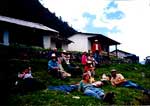|
On our last trip to Guatemala, we tried to get to Chi Chi (Chee Chee), but were warned by a woman driving away from the city with a pickup full of young Indians, that there was a riot in town. Though later we learned the riot was not as bad as we were led to believe, we missed seeing the city.
This trip, less than an hour away from Chichicastinango, we are again stopped on the highway, this time by a student demonstration. High school students are protesting that the government did not send the food promised for school meals. Several of us walk up to the demonstration of thirty to forty young people, a few in masks, who have laid two by fours with nails across the road. The armed road police, part of the long line in front and behind us that includes trucks, UN vans, and buses, remain uninvolved until an hour goes by. They suddenly drive out of the line, weapons drawn, and head to the front. Everyone at the front watching the demonstration runs back to his or her vehicle. The barriers are removed, and the students move to one side allowing traffic through without incident.
Our bus eventually climbs the steep switchback roads that lead to the city late that afternoon, a perfect time to see Chichicastinango, low-keyed, the day before the big market day.
Though people are busy setting up their stands, they are not too busy to beckon us over to show us their wares. The air is heavy with the scent of incense from the nearby church, a popular meeting place for Indians and tourists, of chicken frying at one of the booths, and of leaded gasoline, a scent almost forgotten back home.
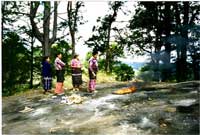 To our surprise, Carl and Lorena have invited Lee Valenti, an American living in Guatemala who we met on our first trip, to join us again in Chichicastinango. As we catch up on each other’s lives over the past four years, and sip freshly made lemonade, Lee mentions a wonderful hike she took earlier that afternoon while waiting for us to arrive. A very old Maya ruin, she explains, is up in the nearby mountains, and though she hadn't seen them, she heard that several groups of Indians used the area for spring rituals.
To our surprise, Carl and Lorena have invited Lee Valenti, an American living in Guatemala who we met on our first trip, to join us again in Chichicastinango. As we catch up on each other’s lives over the past four years, and sip freshly made lemonade, Lee mentions a wonderful hike she took earlier that afternoon while waiting for us to arrive. A very old Maya ruin, she explains, is up in the nearby mountains, and though she hadn't seen them, she heard that several groups of Indians used the area for spring rituals.
Though no one else in the group is in the mood for the climb, I tell Lee I'd love to see the ruin. The following morning, after a trip to a tiny, yet surprisingly delightful museum filled with unusual artifacts like jade earplugs, necklaces, and very old ceramic pots and figures, she agrees to the hike.
The path up the mountain goes right through a mask shop with several rooms of traditional and tourist wooden masks. We continue up the steep pine-scented trail and though both of us think we're in decent physical condition, we are soon huffing and puffing, unaccustomed to the thin mountain air.
 Not a half-hour later, we hear men chanting in the distance. As we near a clearing, we see several groups of people, smoke rising behind them. At the far end, two men in Indian woven pants and skirt-like blankets wrapped around their torso tend a smoky fire. The two women beside them, also in woven skirts and huipiles, eventually cross the clearing with offerings for the black ancient ruin, a female form, at the side of the clearing near us.
Not a half-hour later, we hear men chanting in the distance. As we near a clearing, we see several groups of people, smoke rising behind them. At the far end, two men in Indian woven pants and skirt-like blankets wrapped around their torso tend a smoky fire. The two women beside them, also in woven skirts and huipiles, eventually cross the clearing with offerings for the black ancient ruin, a female form, at the side of the clearing near us.
As unique and primitive as the chanting sounds over the fire, the men's voices are familiar to me. They remind me of the pentatonic sounds of men dovening or praying in the synagogues of my past. As unusual as these men look to me in their skirt-like blankets, I realize for the first time that people outside my religion must have a similar reaction when they first see Jews in prayer shawls and tiffilin, little prayer boxes strapped to the head and arms, as they sway praying in Hebrew.
Across from us, the men continue to chant while the women, now at the ruin, pluck the heads of flowers onto the altar. Directly across the clearing, three other people in jeans and shirts have spread out a picnic blanket with flowers, food and drink. A picnic in the middle of a ceremony?
Soon, however, a man on the blanket rises, taking the flowers, food and bottles of alcohol to the ruin, while the other man wraps his head in a colorful priest's headdress called a tzute, then his waist in the traditional woven faja. The woman silently stands.
"She's a priestess, a Cofradia," Lee whispers, excited. She too had never seen this ceremony.
Standing across from us, the priestess closes her eyes as the man who returns from the altar begins to draw a circle in the dirt beside her with salt. Inside the circle he dribbles out more salt into the letters JHS, the initials for Jesus Christ. Rising, he takes sticks of incense, then candles, and circles them around the woman, as if blessing her. As we wait at the edge of the clearing, the men at our left continued to chant, using a stick to direct the smoke from the fire.
The women once with them are lighting candles at the altar.
Lee tugs my shoulder to warn me that we are late.
I'm riveted by the sight in front of me. "Just a little longer," I whisper.
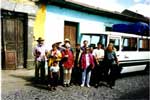 But Lee is worried we will be late for our bus-ride to Antigua, our last stop in Guatemala. I look up as if to say goodbye, taking a last look at the mountain clearing, the view of the city below, and the ruin, when I catch the eye of one of the older women with long black braids at the altar who smiles back at me. Kissing her thumb, she points it toward me as I turn to go.
But Lee is worried we will be late for our bus-ride to Antigua, our last stop in Guatemala. I look up as if to say goodbye, taking a last look at the mountain clearing, the view of the city below, and the ruin, when I catch the eye of one of the older women with long black braids at the altar who smiles back at me. Kissing her thumb, she points it toward me as I turn to go.
The second half of our last day we spend in Antigua, the first city we visited on our last trip, and the old capital of Guatemala. With so little time, I find myself wandering the streets from store to market to old church to cafe trying to absorb as much as I can and buying some last minute gifts, before returning to the United States the next day.
|
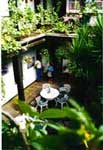 |
|
|
Dona Luisa's Cafe, Antigua
|
|
|
|
|
Once home, it's hard to believe my journey to Central America is over. I am still divided between two worlds. There are instances when a flutter in my stomach accompanies a wistful moment, the memory of traveling the majestic Couchematones, the kiss from the woman on a mountain, the towering ruins in Copan whose discovery solve as many mysteries as they generate. I ache for the feeling of heat and dust across my face; it is still winter back home. Spring is late this year in Detroit, yet I have already welcomed it in the distant mountains above Chichicastenango.
Our group finds excuses to call one another. Wednesday is malaria pill day: we take one each week for three more weeks. Though we live on opposite ends of the city, we meet for lunch. We laugh at similar experiences, meaningless to others, the momentary freak-out of swallowing tap water while brushing our teeth; the hesitation before throwing toilet paper into the toilet instead of a little basket on the side.
|
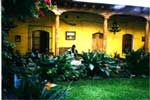 |
|
|
Our Hotel, Antigua
|
|
|
|
|
|
|
|
I've stopped seeing the back of Carl and Lorena's hatted heads in a crowd, and no longer need to take Pepto Bismol two to three times a day to protect my stomach. Yet I fear letting go of any reminder of my time in Guatemala and Honduras, afraid that I will lose the sensations carefully nurtured and gathered during our trip.
|
|

 Part 7
Part 7 To our surprise, Carl and Lorena have invited Lee Valenti, an American living in Guatemala who we met on our first trip, to join us again in Chichicastinango. As we catch up on each other’s lives over the past four years, and sip freshly made lemonade, Lee mentions a wonderful hike she took earlier that afternoon while waiting for us to arrive. A very old Maya ruin, she explains, is up in the nearby mountains, and though she hadn't seen them, she heard that several groups of Indians used the area for spring rituals.
To our surprise, Carl and Lorena have invited Lee Valenti, an American living in Guatemala who we met on our first trip, to join us again in Chichicastinango. As we catch up on each other’s lives over the past four years, and sip freshly made lemonade, Lee mentions a wonderful hike she took earlier that afternoon while waiting for us to arrive. A very old Maya ruin, she explains, is up in the nearby mountains, and though she hadn't seen them, she heard that several groups of Indians used the area for spring rituals. Not a half-hour later, we hear men chanting in the distance. As we near a clearing, we see several groups of people, smoke rising behind them. At the far end, two men in Indian woven pants and skirt-like blankets wrapped around their torso tend a smoky fire. The two women beside them, also in woven skirts and huipiles, eventually cross the clearing with offerings for the black ancient ruin, a female form, at the side of the clearing near us.
Not a half-hour later, we hear men chanting in the distance. As we near a clearing, we see several groups of people, smoke rising behind them. At the far end, two men in Indian woven pants and skirt-like blankets wrapped around their torso tend a smoky fire. The two women beside them, also in woven skirts and huipiles, eventually cross the clearing with offerings for the black ancient ruin, a female form, at the side of the clearing near us. But Lee is worried we will be late for our bus-ride to Antigua, our last stop in Guatemala. I look up as if to say goodbye, taking a last look at the mountain clearing, the view of the city below, and the ruin, when I catch the eye of one of the older women with long black braids at the altar who smiles back at me. Kissing her thumb, she points it toward me as I turn to go.
But Lee is worried we will be late for our bus-ride to Antigua, our last stop in Guatemala. I look up as if to say goodbye, taking a last look at the mountain clearing, the view of the city below, and the ruin, when I catch the eye of one of the older women with long black braids at the altar who smiles back at me. Kissing her thumb, she points it toward me as I turn to go.


